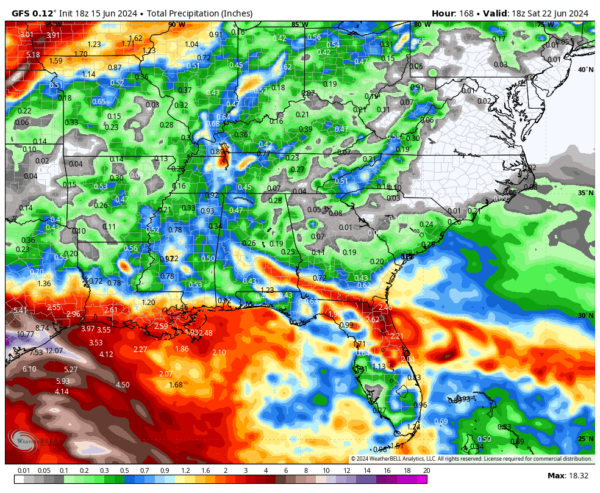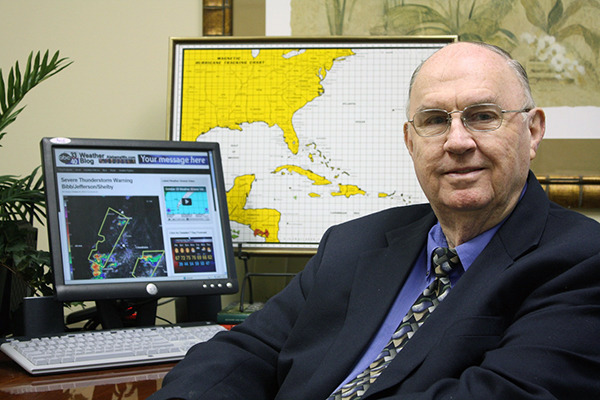Happy Father’s Day! A Hot One in Store…Lots to Talk About
Happy Father’s Day! A special shout-out to all the dads out there on this Sunday morning. Thanks for everything you do, Dad!
SATURDAY STORMS: The atmosphere bubbled over yesterday afternoon as temperatures soared into the 90s. It was 97F at Birmingham, Pell City, Demopolis, and Jasper. It was 99F at Calera. Auburn and Gadsden checked in at 95F. Storms started forming over Clay County by mid-afternoon, and they put out an outflow boundary that helped get things going. Storms were heavy over Tuscaloosa and Jefferson and Shelby counties especially. Much of the Birmingham Metro, especially western and southern sections. Areas from West End to Brighton to Rock Creek in western Jefferson County picked up around 2 inches of rain. No serious flooding was reported.
FOR YOUR SUNDAY: The upcoming week will feature predominantly hot and dry weather across central Alabama. A 500 millibar ridge axis will position across the Mid-Atlantic early in the week. Weak southerly flow across the state will help low-level Gulf moisture slowly creep northward. This may result in isolated diurnal storms, but most areas will remain rain-free today.
DEEPER DIVE INTO TODAY’S RAIN CHANCES: The developing surface high east of the Appalachians will bring SSE winds and a slight increase in low-level moisture. This may be sufficient, combined with the heating of elevated terrain and along differential heating boundaries, to ignite some isolated showers and thunderstorms this afternoon. While the threat is minimal, it’s worth noting that high moisture loading and inverted-V low-level profiles suggest some strong wind potential. High precipitable water values mean some heavy rain will fall as well.
WHAT DOES THAT MEAN? An inverted V sounding, often observed on a thermodynamic diagram, is characterized by dry air (low relative humidity) in the lower troposphere and nearly saturated air (high relative humidity) in the middle troposphere. This profile creates a distinctive inverted V shape due to the sharp contrast between these layers. The Convective Condensation Level (CCL) is at a high elevation, indicating high-based convection, which results in thunderstorms forming at higher altitudes. Such storms often produce less ground-reaching rainfall but can generate significant lightning and wind. The dry lower atmosphere enhances downburst potential, as rain falling from higher layers evaporates, cooling the air and creating strong downdrafts. This cooling can lead to microbursts—intense, localized downdrafts with potentially damaging winds. Therefore, inverted V soundings are critical for predicting high-based thunderstorms and severe wind events, particularly in environments conducive to such atmospheric conditions.
OZONE AND AIR QUALITY FORECAST: Ozone levels today will be in the yellow range, indicating moderate air quality. On Monday, as the ridge shifts east and allows moisture to move in, ozone levels will improve to the green range, signaling good air quality, though PM2.5 will remain in the yellow range. Air quality forecasts are provided by the Jefferson County Department of Health and the Alabama Department of Environmental Management.
WHAT DOES PM2.5 MEAN: PM2.5 refers to fine particulate matter that is 2.5 micrometers or smaller in diameter. These tiny particles are about 30 times smaller than the width of a human hair and can be made up of various components, including acids, organic chemicals, metals, and soil or dust particles. PM2.5 is a significant concern for air quality and public health because these particles can penetrate deep into the lungs and even enter the bloodstream. Exposure to PM2.5 can cause various health issues, such as respiratory and cardiovascular problems, and can aggravate existing health conditions like asthma and heart disease. Monitoring and managing PM2.5 levels are crucial to ensure the air remains safe to breathe, especially for sensitive groups such as children, the elderly, and those with pre-existing health conditions.
CLOSE TO HEAT ADVISORY TERRITORY: Temperatures today in the middle to upper 90s, combined with dewpoints in the upper 60s to lower 70s, will produce maximum heat indices between 100 and 104, nearing advisory criteria. Low temperatures will also be quite warm, allowing very little diurnal relief. This prolonged period of above-normal temperatures will require extra caution for heat-sensitive groups or those with prolonged outdoor activities on Sunday and potentially into early week.
NEW WORK WEEK OUTLOOK: Monday and Tuesday will continue the trend of hot and mostly dry conditions, with the mid-level ridge remaining strong over the Mid-Atlantic region. While temperatures may be slightly cooler than Sunday, there will still be a risk of isolated showers and thunderstorms, especially in the western and southwestern parts of the area. The blended numbers indicate a slight dip in temperatures, but the overall trend suggests continued heat and dry weather.
MIDWEEK: By mid-week, the mid-level ridge will begin to break down slightly due to height falls and energy impulses to our west. Despite this, the pattern will remain mostly dry with above-normal temperatures through the end of the work week. Highs will stay in the lower 90s, and lows will be in the lower 70s, with somewhat lower levels of moisture resulting in dry conditions for Tuesday, Wednesday, and Thursday.
END OF THE WEEK INTO THE WEEKEND: Two things could enhance rain chances by late in the week into the weekend: an approaching front from the northwest and that disturbance zipping across from the Atlantic and Georgia. More about that in a minute.
TROPICAL UPDATE: An area of low pressure may form over the Bay of Campeche and the southwestern Gulf of Mexico by Monday, with potential tropical development by mid-week. This system is emerging from a larger low-pressure area over Central America, known as the Central American Gyre, making forecasting its exact path challenging. Current model guidance is split, with the GFS model suggesting a southern Bay of Campeche track, leading to landfall in southeastern Mexico. In contrast, the European model forecasts a more northern path towards northeastern Mexico. This system will likely become our first named storm, likely steering toward eastern and northeastern Mexico by late Wednesday or Thursday. Heavy rains of 3 to 6 inches are expected along the Texas coast, particularly south of I-10, posing flood threats, with hazardous seas and rough surf along the Texas coast throughout the week.
SECOND SYSTEM POSSIBLE: The National Hurricane Center is also paying attention to a disturbance that could form from a tropical wave as it approaches the Bahamas this week. It could become a tropical depression or troipcal storm before reaching the coast of Northeast Florida or Georgia. No significant impacts for us our our beaches, although it could increase rainfall chances by the weekend.
BEACHCAST: All that talk about the tropics has a bearing on the Alabama and Northwest Florida beaches even though it won’t be a landfalling tropical cyclone there. The rip current risk is going to be high starting today and lasting through much of the week ahead as surf heights rise to 3-6 feet. Showers and thunderstorms will be likely through the period. Highs will be in the middle 80s. Lows will be in the middle 70s. Water temperatures are in the toasty mid-80s.
Click here to see the Beach Forecast Center page.
NATIONALLY: How about 6-12 inches of snow Monday into early Tuesday across western Montana? Snow is very rare in this part of the country into June. Butte, MT, has seen June snow 11 times since 1893.
DANCING WITH THE STATS: Fort Lauderdale has picked up an amazing 140 inches of rain since January 1, 2023, some 59+ inches above normal.
WEATHERBRAINS: This week’s was actually recorded Thursday night and features Kim, Troy, and Neil from the AMS Warnings Conference in Myrtle Beach. Check out the show at www.WeatherBrains.com. You can also subscribe on iTunes. You can watch the show live on our new YouTube channel for the show.You will be able to see the show on the James Spann 24×7 weather channel on cable or directly over the air on the dot 2 feed.
ON THIS DATE IN 1972: Agnes was named on this date, forming as a tropical storm east of the Yucatan Peninsula. Agnes would be a storm with two distinct lives. She would move north over the Gulf of Mexico and strike the Florida Panhandle as a minimal hurricane. A few days later, the remnants of Hurricane Agnes would be rejuvenated over the Northeast, dumping heavy amounts of rain and causing record flooding across area from the 20th through the 24th. Follow my weather history tweets on Twitter. I am @wxhistorian at Twitter.com.
Category: Alabama's Weather, ALL POSTS, Severe Weather, Tropical

















